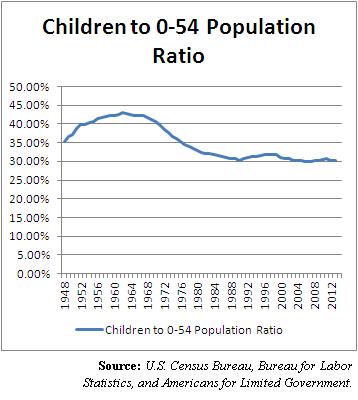Baby Boomers led the march out of the civilian labor force in the past year, data published by the Bureau of Labor Statistics show.
Those not in the labor force increased by 1.9 million from 90.6 million to 92.5 million since September 2013 using non-seasonally adjusted numbers. 70.5 percent of them, 1.3 million, were over the age of 65.
As a percent of the total working age population, seniors not in labor force increased from 14.43 percent to 14.84 percent. This accounts entirely for the drop in overall, non-seasonally adjusted labor force participation rate from 63.2 percent to 62.8 percent in the past year.
Everybody knows that when the Boomers retire, federal Social Security and Medicare budgets are set to explode. Have we finally reached that tipping point?
This could be the beginning. In 2013, senior labor participation peaked at an annual average of 18.7 percent. So far in 2014, that has dropped some, to 18.6 percent. That is after the rate had risen every year since 1998.
That’s still a pretty high rate by historical standards. Seniors are still working longer than at any time since the 1960’s — when life expectancy was much lower — but as the rate continues to drop, that will be the surest indicator that the retirement wave has hit.
So, what does that mean for the budget?
The Congressional Budget Office projects that by 2024, Social Security and Medicare spending will have nearly doubled to $1.5 trillion and $1.1 trillion respectively, accounting for about 40 percent of the total budget.
In the meantime, although budget deficits have shrunk a little in a short-term, they will be increasing again dramatically, first to $539 billion in 2016, and then to more than $1 trillion by 2022.
This probably wouldn’t be such a problem, but in the past 50 years, families in the U.S. have not been having as many children, data compiled by the U.S. Census Bureau and Bureau of Labor Statistics shows.
The number of children aged 0-16 as a percentage of those aged 0-54 has decreased from a peak of 42.8 percent in 1963 to just a little over 30 percent today. If it had remained where it was, there might be as many as 68 million more potential taxpayers in the 16-54 working age.
All of which means that the U.S. faces a fiscal crisis based on a demographic time bomb that is at the beginning stages of going off. And no amount of political posturing will change this fact.
Until we are willing to have an honest discussion about national priorities and federal spending for seniors, the situation will continue to deteriorate.
Robert Romano is the senior editor of Americans for Limited Government.








